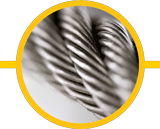Important Wire Rope Warnings

Important wire rope warnings
WIRE ROPE IS A MACHINE. Understand and respect it. Like any machine, it needs proper care and maintenance for optimal safety and long service life. For a better understanding of wire rope we highly recommend the Wire Rope Users Manual by the Wire Rope Technical Board. Excerpts of that manual have been reprinted in the wire rope section of this catalog. Refer to the General Warnings on pages (##). These warnings also apply to wire rope. Only additional warning and information are listed below. Rated Capacity
Rated capacity is the load which a new wire rope may handle under given operating conditions and at assumed design factor. A design factor of 5 is chosen most frequently for wire rope. (Operating loads not to exceed 20% of catalog Breaking Strength.) Operating loads may have to be reduced when life, limb or valuable property are at risk or other than new rope is used. A design factor of 10 is usually chosen when wire rope is used to carry personnel. (Operating loads not to exceed 10% of catalog Breaking Strength.) Responsibility for choosing a design factor rests with the user.
Attachments must have at least the same Working Load Limit as the wire rope used.
Keep out from under a raised load.
Inspect wire rope regularly.
Two of the most important prerequisites for inspecting wire rope are technical knowledge and experience. Check the general condition of the wire rope. Also, look for localized damage and wear, especially at wire rope attachments. Inspect all parts that come in contact with the wire rope. Poor performance of wire rope can often be traced back to worn or wrong-sized sheaves, drums, rollers, etc. Look for kinks, broken wires, abrasions, lack of lubrication, rust damage, crushing, reduction of diameter, stretch or other obvious damage. If any of these conditions exists or if there is any other apparent damage to the wire rope, retire the wire rope according to the instructions below.
When in doubt about the extent of the damage, retire the wire rope in question immediately. Without laboratory analysis, it is impossible to determine the strength of damaged or used wire. Thus, you will not be able to tell whether wire rope with any amount of damage is safe to use. Retire the wire rope that is damaged. For specific inspection procedures, check various OSHA and ANSI publications. Destroy, rather than discard, wire rope to be retired.
Wire rope that is not destroyed might be used again by someone not aware of the hazard associated with that use. Destroying wire rope is best done by cutting it up into short pieces.
Refer to General Information on Wire Rope for important characteristics and properties of wire rope.
WIRE ROPE IMPORTANT WARNINGS: failure to follow warnings and instructions can result in serious injury or death.